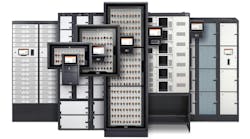New Strategies in Design to Meet the Demands of AI Data Centers
In the data center industry, rack densities have been predicted to trend upward for over a decade, but until the advent of artificial intelligence (AI), these predictions have been unrealized. AI data centers present unique challenges in terms of rack densities and in terms of scale. It is not uncommon to see data centers of 1 GW with liquid-cooled racks with densities over 100 kW. In the future, we will see even larger data centers with higher rack densities.
One projection is for rack densities over 500 kW per rack. To accommodate the larger scale and higher densities, there must be a significant shift in the design of efficient, sustainable, high-capacity data centers. One thing is clear: To manage this scale, we will need to change our concept of design beyond GPUs and cooling innovations.
Using only existing designs and topologies has created limitations for data center builders to meet the scale required to handle increasing computational demands, all without necessarily expanding physical footprint or taking on new risk. Operators are now turning to suppliers like ABB with the challenge of bringing new design concepts to the table that address these needs. When it comes to electrical systems, sizing for future capacity up front to meet rising densities will provide a more optimal solution.
As the demand for power density increases, especially with the advent of AI and supercomputing, the limitations of existing low voltage (LV) products are becoming apparent. The limitations in LV topology (3MW), such as the maximum sizes for breakers and UPS modules, are becoming more pronounced. LV products, traditionally used over the past 15 to 20 years, are now seen as limiting factors due to their building block sizes, which are not scalable to the current needs of large-scale data centers. The most viable solution to support the growing scale of data centers is to integrate more medium voltage (MV) systems.
Flexibility and Reliability in MV Systems
Medium-voltage systems offer more flexibility compared to LV systems. They allow for better utilization of MV assets, such as generators, UPSes, and batteries, which can support grid functions and reduce the dependency on generators. MV UPS systems can deploy energy storage solutions for extended periods (two to four hours), unlike LV UPS systems, which have limited battery deployment capabilities. This flexibility supports longer operational shifts during outages and enhances overall reliability.
Installation Efficiency and Space Optimization
Modern data center designs that now cater precisely to workload specifications must ensure that each square foot is utilized to its maximum potential. From an installation perspective, MV systems are more efficient than LV systems. LV systems operating at 480 V pull higher amperages and require larger cables, increasing installation costs. Extending MV architecture can lead to installed cost savings and space optimization, as MV equipment is typically placed in outdoor enclosures or buildings, freeing up more space inside data centers for IT equipment.
Design Considerations and Operational Adjustments
Newer methods to operate at MV levels more closely align with how utilities operate, making integration easier. Historically, power is distributed from the power plant to the substation and power grid at MV levels and then “stepped down” to LV at its point of use. As data center designers develop concepts that challenge suppliers to provide solutions that can handle higher power densities, suppliers who have a wealth of experience with other industry verticals can examine how other heavy power-use industries such as oil and gas, food and beverage, and industrial manufacturing operate, where medium voltage has been the primary concept to handle larger loads for a long time.
With the adoption of a new system, some design, maintenance, and operational adjustments will need to be made. Addressing power quality concerns at the MV level involves advanced UPS systems that offer power protection and backup capacity. Additionally, MV systems require a different level of training and operator experience, highlighting a gap in current workforce capabilities. Partnering with a supplier who has the disposition to train your staff on these adjustments will be crucial.
MV integration will require the engineering team to adapt designs for new considerations, shifting much of the conversation to what data center operators are comfortable with for their site’s reliability, redundancy, and scalability. The selection of breakers, busway systems, and switches will need to be reconfigured because certain topologies simply are not available yet. It is important to recognize that there are ways to achieve the same outcome by deploying new architectures. For example, instant transfer switches do not exist at MV loads, but a data center can deploy a ring bus or shared redundant feed to connect different blocks of UPS modules to different loads. Having a power partner who can help craft your one-line to provide similar reliability and the desired redundancy will be crucial.
Cost Considerations and Environmental Impact
CAPEX costs of MV equipment are traditionally higher than LV equipment. However, the cost/benefit equation may favor MV systems in the long run due to their ability to support higher power densities, more efficient installations, and lower maintenance costs due to less overall equipment versus LV topologies. There may also be additional ways to offset costs.
Another consideration for a long-term outlook is that of environmental impact. One significant benefit of MV systems is their alignment with modern utility trends, such as battery technology, electric vehicles, and energy storage for renewable generation. Batteries are becoming an increasingly popular solution for critical reserve power, and the convergence of UPS and BESS integration offers a cleaner and more sustainable alternative to diesel generators, which are high-cost, low-use assets. Batteries can be used for peak shaving and grid support and provide backup power during outages, enhancing the overall efficiency and environmental impact of data centers.
Moving Forward with Medium Voltage
The future of data center densities hinges on the ability to adapt designs dynamically, integrate sustainable practices, and collaborate closely with power distribution partners and utility providers. As technologies evolve and demands increase, data centers must continue to innovate in their structural and operational strategies to remain efficient and competitive. The ongoing adjustments in data center deployments, the need to conserve space, and the strategic evolution of designs will all play a crucial role in shaping the next generation of data centers.
Sponsored by:
About the Author
Yasir Shinaishin; Solutions Director - Critical Power Systems, ABB Electrification Products
Yasir Shinaishin is a Critical Power Solutions Architect with ABB Electrification's Power Protection Business and is based in Los Angeles, CA. Yasir specializes in the design and implementation of critical power electrical systems for data centers and other mission critical applications and works with end users, consulting engineers, contractors and integrators to provide efficient and comprehensive solutions to address their needs. Yasir has over 20 years of experience in the electrical critical power and data center industries in various technical and commercial roles.



